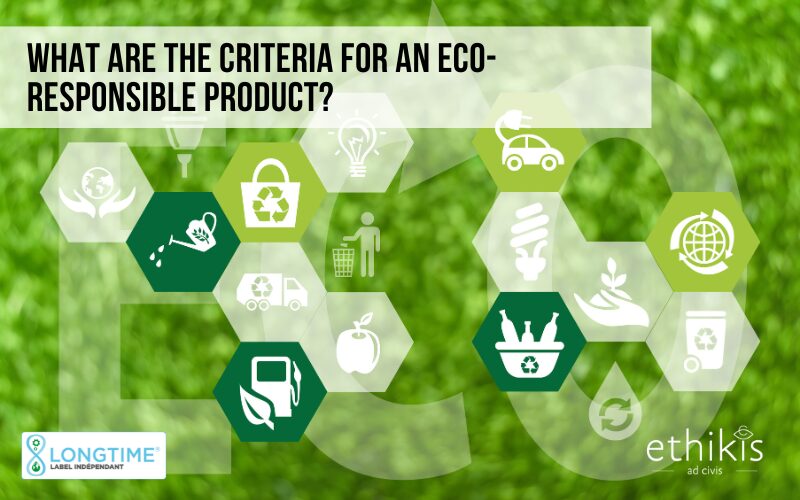
What are the criteria for an eco-responsible product?
An eco-responsible product is one that is designed, manufactured and distributed in such a way as to minimize its environmental impact throughout its life cycle. This includes production, use and end-of-life (recycling, reuse), but also the social conditions of manufacture. These products not only reduce their ecological footprint, but also promote sustainability and a more responsible business model, integrating ethical and environmental practices.
The criteria for an eco-responsible product encompass several crucial aspects that define not only their impact on the planet, but also working conditions and human rights.
1. Reducing carbon footprint
Reducing the carbon footprint is one of the main objectives of eco-responsible products, in order to limit the effects of climate change.
Reducing emissions during manufacturing
Companies can reduce their carbon footprint by optimizing their manufacturing processes to emit fewer greenhouse gases. This includes using low-CO2 materials, optimizing supply chains to reduce distance travelled, and switching to cleaner production technologies.
Environmentally-friendly transport
Product transport is a major source of greenhouse gas emissions. To minimize this impact, companies are opting for more environmentally-friendly transport solutions, such as sea freight rather than air freight, or the use of electric vehicles for local distribution. Reducing the size of products or their packaging also helps reduce the volume of transport required.
Reduced power consumption during use
Some products, such as household appliances, are designed to consume less energy and therefore produce fewer emissions during use. Electric cars, for example, emit no CO2 during operation, thus helping to reduce overall emissions.
2. Energy efficiency
Energy efficiency refers to the reduction of energy consumption during all stages of a product’s life cycle.
Reduced energy consumption during manufacturing
Companies producing eco-responsible products often adopt energy-efficient production technologies. This can include using more efficient machinery, optimizing manufacturing processes to avoid wasting energy, or recovering heat for reuse in other parts of the process.
Use of renewable energy sources
Some eco-responsible products are manufactured in factories powered by renewable energy sources, such as solar or wind power. By favoring these less polluting energies, companies reduce their carbon footprint and their dependence on fossil fuels.
Product energy efficiency
Once in use, eco-responsible products are designed to consume less energy. For example, low-energy household appliances and LED light bulbs consume less energy during use, helping to reduce overall energy demand.
3. Waste reduction
Eco-responsibility also aims to limit waste production throughout the product life cycle.
Design for repairability
Eco-responsible products are often designed to be repairable. For example, electronic devices such as telephones or laptops can be easily dismantled, enabling the repair of individual parts rather than throwing away the whole product. Modular design, with interchangeable components, also promotes this idea of sustainability.
Reusable products
Instead of favoring disposable products that contribute to waste, more and more eco-responsible products are reusable. Products such as water bottles, cloth bags and reusable coffee filters help reduce the amount of waste generated and promote a circular economy.
Recycle and reuse
Eco-responsible products are often designed with materials that are easy to recycle or reuse. Minimalist packaging, or the use of reusable packaging, helps to reduce packaging waste. What’s more, at the end of their life cycle, these products can be easily recycled or transformed into new products.
4. Use of sustainable and renewable materials
One of the fundamental principles of eco-responsible products is the use of materials that have a minimal impact on the environment and are renewable or recyclable.
Renewable materials
Renewable materials are derived from resources that regenerate naturally within a reasonable period of time. This includes, for example, wood from sustainably managed, FSC-certified forests, or organic cotton grown without pesticides or chemicals harmful to soils and ecosystems. These materials help reduce the exploitation of natural resources while preserving biodiversity.
Recycled materials
Many eco-responsible products incorporate recycled materials, reducing the consumption of primary resources. The use of recycled plastics, recycled metals or recovered glass reduces waste and avoids the need for virgin materials, which often require energy-intensive and polluting manufacturing processes.
Biodegradable materials
Biodegradable materials, such as cardboard, paper or plant-based packaging, have little impact on the environment, since they decompose naturally and don’t cause long-term pollution. This alternative is becoming increasingly popular for packaging products, limiting the accumulation of non-recyclable waste.
5. Fair working conditions
Eco-responsibility isn’t just about the environment. It also includes a social aspect, aimed at guaranteeing fair and humane working conditions throughout the production chain.
Fair trade and fair remuneration
Eco-responsible products often comply with fair trade standards, guaranteeing fair prices for producers, particularly in developing countries. This includes working conditions that respect employees’ rights, as well as a decent wage that enables them to live with dignity.
Worker safety and well-being
When it comes to manufacturing products, worker safety is a priority. Companies must provide a safe and healthy working environment, in compliance with health and safety standards. They can also offer training and development opportunities to enhance the well-being of their employees.
6. Positive impact on biodiversity
Eco-responsible products are designed to have minimal impact on biodiversity and ecosystems.
Sustainable farming practices
Agriculture plays a key role in the production of many products. Organic or sustainable farming limits the use of chemicals, preserves soil quality and protects local animal species. Regenerative agriculture, for example, seeks to restore soil and biodiversity while producing food or industrial resources.
Preserving natural habitats
Some companies are taking steps to prevent the degradation of natural habitats, by ensuring that their sourcing practices do not lead to the destruction of ecosystems. For example, responsible mining and sustainable forestry are practices that reduce environmental impact while preserving local biodiversity.
Conclusion
Adopting eco-responsible products is much more than making an ecological choice: it’s making a commitment to a sustainable, ethical and socially responsible consumption model. By integrating criteria such as carbon footprint reduction, energy efficiency, waste reduction, use of sustainable materials, fair working conditions and biodiversity preservation, these products play an active part in the ecological transition. They enable consumers to become agents of change, by directing their choices towards alternatives that respect the environment and human beings. Faced with today’s environmental and social challenges, eco-responsibility is no longer an option, but a necessity.
*** Translated with www.DeepL.com/Translator (free version) ***
